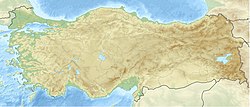 Ancient entrance to the city | |
| Location | Antalya Province, Turkey |
|---|---|
| Region | Pisidia |
| Coordinates | 37°10′52″N 30°28′21″E / 37.18111°N 30.47250°E |
| Type | Settlement |
| Site notes | |
| Condition | In ruins |
Ariassus or Ariassos (Ancient Greek: Ἀριασσός) was a town in Pisidia, Asia Minor built on a steep hillside about 50 kilometres inland from Attaleia (modern Antalya).
History
[edit]Classical Age
[edit]Hellenistic period
[edit]The town was founded in the Hellenistic period in the 3rd century BC.[1] It was mentioned (as Aarassos) in about 100 BC by Artemidorus Ephesius, who was quoted by Strabo a century later. The only further mentions are by Ptolemy in the 2nd century AD and in lists of Christian dioceses (Notitiae Episcopatuum).[2]
It was part of Pisidia and belonged originally to the Seleucid Empire. In 189 BC it passed to the Hellenistic kingdom of Pergamum.
Roman period
[edit]In 133 BC, Attalus III of Pergamum left his kingdom to the Roman Republic.[3]
Under Octavian Augustus, Ariassos was made part of the Roman province of Galatia.[2] In the ecclesiastical lists it appears in the late Roman province of Pamphylia Secunda, whose capital was Perge, hence also its bishopric's Metropolitan.
Remains
[edit]
Coins minted at Ariassos are extant.[4][5]
The ruins are mainly of Roman and Byzantine times, with few remains of the earlier Hellenistic period. The best preserved is that of the 3rd-century-AD triple-arched city entrance once surmounted by four statues. Other buildings include an extensive nymphaeum and baths, as well as a large domestic area. There is an abundance of funerary monuments.[6][7]
Bishopric
[edit]The names of three bishops of the see of Ariassus are known: Pammenius (at the First Council of Constantinople in 381); Theophilus (at the Council of Chalcedon in 451); and Ioannes (signatory of a joint letter of the bishops of the province to Emperor Leo I the Thracian in 458).[8][9]
Titular see
[edit]No longer a residential bishopric, Ariassus is today listed by the Catholic Church as a titular see.[10]
Nominally restored as a Latin titular bishopric in 1911, it is vacant, having had the following incumbents, all of the lowest (Episcopal) rank :
- Jules-Joseph Moury, Society of African Missions (S.M.A.) (1911.01.17 – 1935.03.29)
- Leoncio Fernández Galilea, Claretians (C.M.F.) (1935.06.18 – 1957.02.15)
- Jean Fryns, C.S.Sp. (1957.04.12 – 1959.11.10)
- Cesar Gerardo Vielmo Guerra, Servites (O.S.M.) (1959.12.19 – 1963.06.16)
- Ignacio María de Orbegozo y Goicoechea (1963.10.29 – 1968.04.26)
References
[edit]- ^ Kemer Turkey Info, "Ariassos"
- ^ a b Stephen Mitchell, Edwin Owens and Marc Waelkens, "Ariassos and Sagalassos 1988" in Anatolian Studies, Vol. 39, 1989
- ^ S. Rinaldi Tufi, "Ariassos" in Enciclopedia dell'Arte Antica (1994)
- ^ Ancient Coinage of Pisidia, Ariassus
- ^ Asia Minor Coins: Ariassos
- ^ Sarah H. Cormack, "The Roman-Period Necropolis of Ariassos, Pisidia" in Anatolian Studies, vol. 46, Dec. 1996, pp. 1–25
- ^ Antik Şehirler: Ariassos
- ^ Michel Lequien, Oriens christianus in quatuor Patriarchatus digestus, Paris 1740, Vol. I, coll. 1023-1024
- ^ Pius Bonifacius Gams, Series episcoporum Ecclesiae Catholicae, Leipzig 1931, p. 450
- ^ Annuario Pontificio 2013 (Libreria Editrice Vaticana 2013 ISBN 978-88-209-9070-1), p. 838




